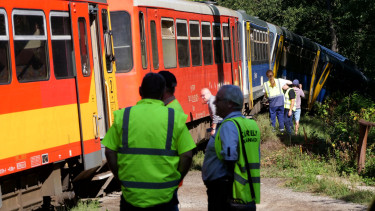MÁV Group CEO addresses derailment - How bad is the situation in Hungary?

In his post, he emphasised that further findings required detailed investigation and
ordered an immediate investigation.
Zsolt Hegyi emphasised that the MÁV Group treats derailment accidents very seriously, and this case is no exception.
In the vast majority of such cases, it is not a single cause, but rather a combination of several unfortunate circumstances, that leads to the accident,
wrote the MÁV Group CEO.
He added that, regardless of the specifics of the case in question, it is a fact that Hungary's secondary railway lines are in dire need of renovation and development in terms of both their rolling stock and their infrastructure.
To achieve this, we have accelerated our programmes for procuring vehicles and renovating tracks on the Hungarian railways, so that we can resume train services on the main lines as soon as possible, either by leasing vehicles or by developing infrastructure with the help of loans, he said. This will immediately create new opportunities for the renewal of branch lines, the replacement of Bz trains, and the reuse of high-quality track elements recovered from main lines for new purposes, Hegyi stressed.
In his concluding remarks, he wished his injured colleagues a speedy and full recovery and apologised to the affected passengers. Furthermore, he promised that they would do everything in their power to ensure that the 75 line is safe for travellers again, just as it is elsewhere.
Although the number of train derailments in Hungary may seem extremely low — there were only three in 2023 — the country was actually ranked 8th in the EU in this category that year.


2023 rail accident statistics - Hungary shows improvement in CEE
In 2023, 1 567 significant railway accidents were reported in the EU. A total of 841 people were killed in these accidents, while another 569 people were seriously injured. At EU level, the number of fatalities in railway accidents decreased gradually over the last 13 years, from 1 245 in 2010 to 841 in 2023, a fall by 32.4%, according to data by Eurostat, the statistical office of the European Union.
However, it should be noted that from 2019 to 2021, the decreases in railway accidents, fatalities and seriously injured people coincided with a sharp drop in passenger transport by rail caused by the COVID-19 pandemic. The large increase in remote working and home schooling, combined with recommendations to avoid unnecessary travel during the pandemic, contributed to the rail passenger transport almost halving in the EU.
With the end of the pandemic restrictions, rail traffic increased significantly, which can explain the increase observed in the number accidents and consequently in the number of fatalities in 2023 compared to 2021 (+23.1%).
Suicides occurring on railways are reported separately. With 2 371 reported cases in 2023, suicides outnumbered the victims accounted for by railway accidents.

On average over the ten years between 2014 and 2023, the number of suicides involving railways in the European Union was 2.8 times higher than the number of fatal railway accidents. In Hungary, however, this multiplier was just 1.3 in the same period.

The number of rail accidents per one million inhabitants was the highest in Slovakia (12) in 2023, followed by Czechia (8.7), Slovenia (8), and Hungary (7.3). The EU average was 3.5. The top three in 2022 were Czechia (10.4), Hungary (10.1), and Slovakia (10.

In 2022, 1.88 people died in railway accidents per one million inhabitants in the EU.
The highest rates of people killed in railway accidents were recorded in Slovakia (6.8), Hungary (4.8), and Poland (4.3). The Top3 in 2022 were Hungary (7.8), Croatia (4.7), and Poland (4.5).

There was improvement in Hungary from 2022 to 2023 not only in the number of fatal rail accidents but also a decrease in the number of rail accidents resulting in serious injury, while the latter increased in the EU.

In 2023, the number of fatalities and serious injuries among level crossing users in Hungary dropped sharply, whereas in the EU, it only dropped slightly.

And finally a look at Central and Eastern Europe on a longer period (2012-2023) and a shorter one (2018-2023).

Cover photo: MTI Photo/Zoltán Mihádák








